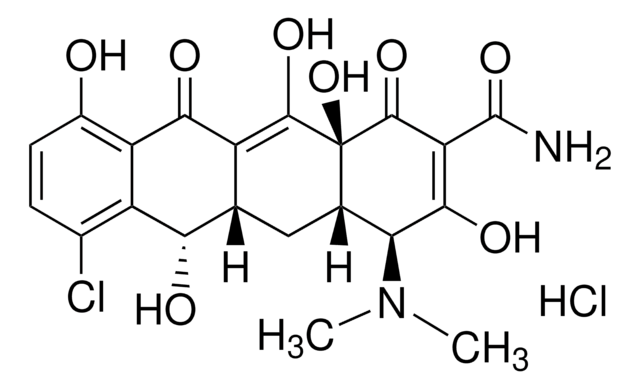D6140
Demeclocycline hydrochloride
powder or crystals, suitable for cell culture
Synonym(s):
7-Chloro-6-demethyltetracycline hydrochloride, Demethylchlorotetracycline hydrochloride
About This Item
Recommended Products
product name
Demeclocycline hydrochloride, powder or crystals
Assay
89.5-102.0% anhydrous basis
form
powder or crystals
technique(s)
cell culture | mammalian: suitable
solubility
soluble (1 mg/mL of Demeclocycline Hydrochloride in 0.01 N hydrochloric acid)
antibiotic activity spectrum
Gram-negative bacteria
Gram-positive bacteria
Mode of action
protein synthesis | interferes
storage temp.
−20°C
SMILES string
Cl[H].[H][C@]12C[C@@]3([H])[C@H](N(C)C)C(O)=C(C(N)=O)C(=O)[C@@]3(O)C(O)=C1C(=O)c4c(O)ccc(Cl)c4[C@H]2O
InChI
1S/C21H21ClN2O8.ClH/c1-24(2)14-7-5-6-10(16(27)12-9(25)4-3-8(22)11(12)15(6)26)18(29)21(7,32)19(30)13(17(14)28)20(23)31;/h3-4,6-7,14-15,25-26,28-29,32H,5H2,1-2H3,(H2,23,31);1H/t6-,7-,14-,15-,21-;/m0./s1
InChI key
GVSJQNRGSCOSNJ-KBHRXELFSA-N
Looking for similar products? Visit Product Comparison Guide
Related Categories
General description
Biochem/physiol Actions
Signal Word
Warning
Hazard Statements
Precautionary Statements
Hazard Classifications
Acute Tox. 4 Dermal - Acute Tox. 4 Inhalation - Acute Tox. 4 Oral - Eye Irrit. 2 - Muta. 2 - Skin Irrit. 2 - STOT SE 3
Target Organs
Respiratory system
Storage Class Code
11 - Combustible Solids
WGK
WGK 2
Flash Point(F)
Not applicable
Flash Point(C)
Not applicable
Personal Protective Equipment
Certificates of Analysis (COA)
Search for Certificates of Analysis (COA) by entering the products Lot/Batch Number. Lot and Batch Numbers can be found on a product’s label following the words ‘Lot’ or ‘Batch’.
Already Own This Product?
Find documentation for the products that you have recently purchased in the Document Library.
Customers Also Viewed
Our team of scientists has experience in all areas of research including Life Science, Material Science, Chemical Synthesis, Chromatography, Analytical and many others.
Contact Technical Service










